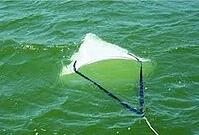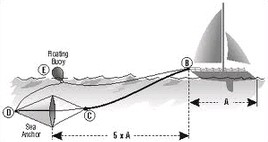- 781-659-2262
Last month’s blog centered on getting your boat ready for the upcoming summer season. Hopefully, it will be a happy time with no surprises. On that note however, what if you do encounter a situation where you are on the open water and a sudden storm occurs? In keeping with that thought, I came across the following article published by United Marine Underwriters which offers a way to keep your boat in place until help arrives.
"It is common for small boats to be caught offshore in squalls or storms. Greater fuel capacity and modern engines allow them to venture well offshore without fear of having enough fuel to make port. An item normally found on sailboats and trawlers but seldom on small pleasure crafts is a sea anchor.
 A Sea Anchor is a conical shaped device that, when properly deployed and of the proper size, will hold a vessels bow to the sea and reduce the danger of broaching. A sea anchor will not hold your boat in place but it will hold your vessels bow to the seas until help arrives or you are able to complete repairs to allow you to get underway.
A Sea Anchor is a conical shaped device that, when properly deployed and of the proper size, will hold a vessels bow to the sea and reduce the danger of broaching. A sea anchor will not hold your boat in place but it will hold your vessels bow to the seas until help arrives or you are able to complete repairs to allow you to get underway.
Once deployed it should be set to ride just below the surface, on a wave ahead. When on the crest of a wave, the sea anchor should be on the crest of the next forward wave. Depending on the distance between waves, you may get a smoother ride with the sea anchor 2 or 3 waves ahead of your position.
 You must use a trip line (release line) when using a sea anchor. It is attached to the apex of the anchor and is used to dump the sea anchor and allows it to be retrieved backwards. The line is smaller in size, usually equipped with a float or two, and it must be longer than the main rode. The main rode of the anchor should be at least 10 to 15 times the length of your boat. Use of chain at either end of the rode will allow the nylon line between the chains to stretch and act as a shock absorber in the pull of the sea anchor.
You must use a trip line (release line) when using a sea anchor. It is attached to the apex of the anchor and is used to dump the sea anchor and allows it to be retrieved backwards. The line is smaller in size, usually equipped with a float or two, and it must be longer than the main rode. The main rode of the anchor should be at least 10 to 15 times the length of your boat. Use of chain at either end of the rode will allow the nylon line between the chains to stretch and act as a shock absorber in the pull of the sea anchor.
Sea anchors are made of canvas or nylon material, compactly fold up and take very little space to store. When shopping for one read the packaging carefully. Some are made for trolling, they slow a vessel’s speed when trolling but are not made to serve in a “storm.”
If you are caught offshore in heavy seas and do not have a sea anchor, try tying a bucket, canvas bag or any object that will float just below the surface to a line fixed to your bow. It may act as a makeshift sea anchor long enough to help steady your vessel until conditions improve. When you put a sea anchor aboard, test the distance that is most comfortable and try positioning it on various bow cleats. You may wish to use a bridle at the bow to fasten it. If you practice with it a few times, you will know the easiest and fastest way to deploy it should the need arise."
This article was published with permission from United Marine Underwriters. Read the original article on their web site here. Learn about watercraft insurance here.
We are local insurance experts serving the South Shore for over 70 years.
Click below to get a free quote for your personal or business insurance.